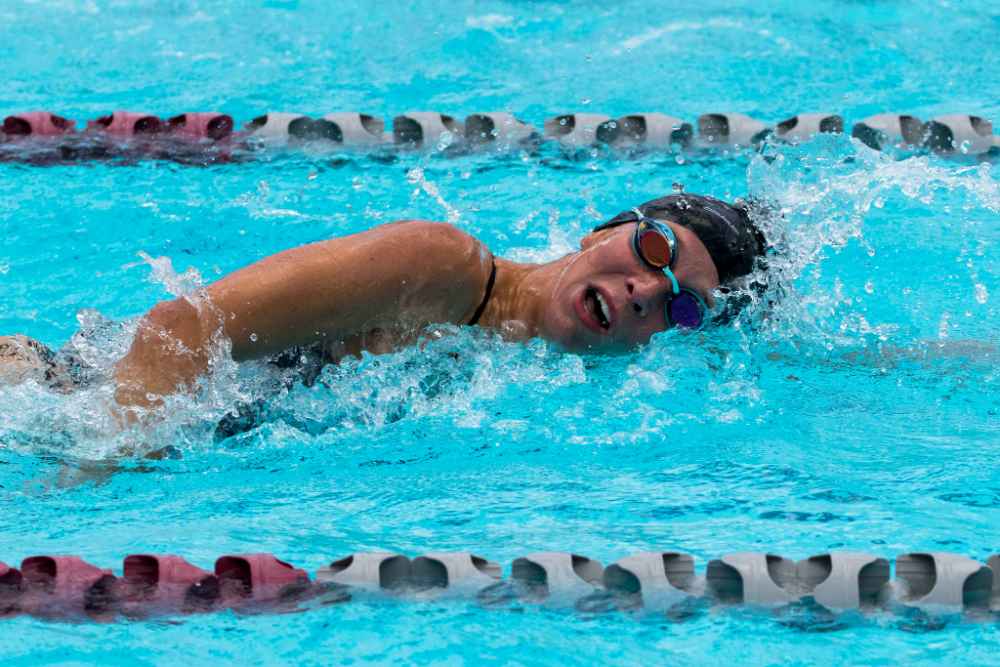Everyone knows how critical swim goggles are. But what’s the best way to wear them, over or under a swim cap? We tackle this time-tested question.
One of the most essential pieces of equipment for any swimmer is their trusty set of swim goggles.
They perform a variety of functions, not limited to improving visibility in the water, reducing those pesky red and itchy eyes, and even helping you swim with better technique.
It’s rare to meet a swimmer who doesn’t grasp the utility of swim goggles.
But when it comes to swimming goggles being under or over your swim cap, that’s where things start to get tricky.
There are some excellent arguments for both, and ultimately, it comes down to the kind of swimming you are doing and your comfort levels.
In this article, we will look at both sides of this debate.
Let’s dive right in!
Swim Goggles Over the Cap
Let’s start with what could be considered the more traditional approach—wearing your favorite set of swimming goggles over a swim cap.
🏊 Easy to adjust the goggle straps and sockets.
For novice swimmers who are getting used to swimming goggles, placing the straps over the swim cap gives you easy access to the head straps.
It’s a reality that sometimes you need to tighten your goggles mid-workout, and removing both the cap and goggles to make an adjustment can eat up time that is better spent swimming.
Additionally, there may be a time when you need a wholesale adjustment of the angle of the straps leading into the goggle sockets.
Fixing these issues, which are common to both novice and experienced swimmers, is a piece of chlorinated cake when the straps are sitting on top.
🏊 Less restrictive.
Wearing your goggles for two hours straight can leave your face and eye sockets feeling a little sore.
There will be times when you want to take off your swim goggles, whether that’s for some social kicking with your teammate or during a break between sets.
Related: Why You Should Always Wear Swim Goggles When Lap Swimming
When the cap is over the goggles, you can’t take the swim goggles off for a “breather” without having to reapply everything.
🏊 Goggle straps won’t pull or tug on the hair.
For swimmers with long hair, wearing your swim goggles over the cap is a big win.
Goggle straps move around on the head when swimming, doing kick on a board, flip turns, and all the rest.
Placing goggles over the cap mean the straps aren’t tugging and pulling on your hair over the course of your workout.
Swimming Goggles Under the Cap
Next up, is the more “competitive” style of strap and cap placement.
Here’s why swimmers put goggles under their caps when hitting the water.
🏊 Keeps your swim goggles in place.
Know what every swimmer’s worst nightmare is? Goggles leaking or outright falling off when they dive into the water on race day.
Wearing goggles under a cap will *almost* completely eliminate this possibility.
The cap locks the straps into place, so they won’t slide and move when hitting the water or when swimming at high speed. Goggle straps can catch water and fold over at very high speeds.
Competitive swimmers cannot waste a moment adjusting their goggles on race day, so securing their goggles under the cap makes logical sense and gives swimmers a little confidence knowing that their equipment won’t fail them when it matters most.
🏊 Creates a more hydrodynamic profile in the water.
This again applies primarily to serious swimmers who are out to maximize every last ounce of their preparation and hard work. However small, goggle straps create a tiny bit of resistance and drag in the water. When swimmers are moving at peak speeds, they are streamlined and trying to be as efficient as possible.
The fewer obstacles swimmers give the water to hit and bounce off of, creating more drag and slowing them down, the better.
What about putting your goggle strap between two caps?
Want the best of both worlds?
The reduced hair tugging of wearing a cap over your goggles combined with the strap security and drag reduction of wearing your goggles under your cap?
Then consider wearing two caps and putting the goggle straps between them.
Here’s how this works:
- The bottom layer (usually a latex or Lycra cap, which is comfortable and won’t tug on the hair) is put on.
- Then the goggles.
- And then a silicone swim cap, locking your swim goggles into place.
Voila, a swim goggle/swim cap sandwich!
Plenty of elite swimmers do this, including among them Katie Ledecky, who wore two caps with her goggles between them at the Tokyo Olympics.
This method is generally reserved for competitive swimmers, but if it’s what makes you comfortable at the lap pool, go for it!
At the end of the day, whether you put your goggles under your cap, over your cap, or between a pair of caps, you wanna hit the water with confidence.
Got more questions about swim goggles?
I’ve got answers!
Check ‘em:
✔️ Frustrated with goggles that keep leaking? Here is a simple step-by-step guide to troubleshooting leaky swim goggles.
✔️ Swim goggles come in a variety of tints and lenses. Here’s a detailed look at figuring out which lenses to get for your next set of swimming goggles.

Beau Cormier is a former NCAA I swimmer, US Open National finalist, and swim nerd. When not swimming or working for a data company, you can find him running the trails of the Pacific Northwest with his wife and dogs.
